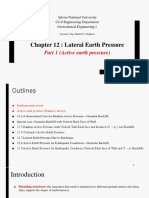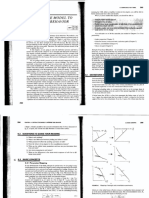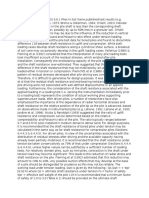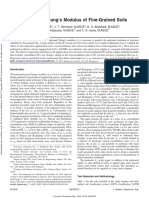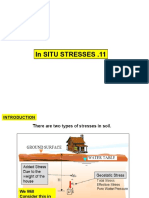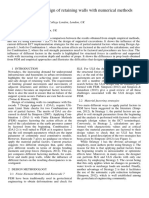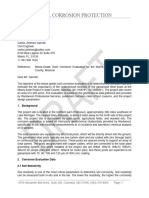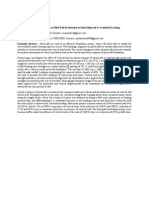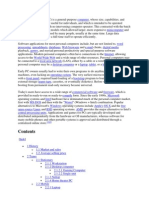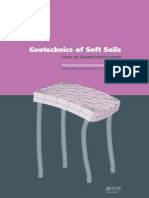Strength and Stiffness Properties
Strength and Stiffness Properties
Uploaded by
riz2010Copyright:
Available Formats
Strength and Stiffness Properties
Strength and Stiffness Properties
Uploaded by
riz2010Original Description:
Copyright
Available Formats
Share this document
Did you find this document useful?
Is this content inappropriate?
Copyright:
Available Formats
Strength and Stiffness Properties
Strength and Stiffness Properties
Uploaded by
riz2010Copyright:
Available Formats
31
3
3
SHEAR STRENGTH AND
STIFFNESS OF
COHESIONLESS SOIL
In this chapter, and the next, the soil properties are discussed under two
headings shear strength and stiffness. This distinction is simply one of
convenience because the behaviour of the materials forms a complete whole.
The range of phenomena associated with the stress-strain-strength behaviour
of soil is extensive, complex and potentially bewildering. The purpose of these
two chapters is to present an overview of these aspects.
Note regarding notation: In this chapter and the next a considerable amount
of data obtained from triaxial testing is presented. There are two sets of
parameters in common use for stresses and strains in triaxial specimens.
Unfortunately these use the same symbols! One set, which originated with the
stress path method developed by the people at MIT in Massachusetts, and is
used extensively in the Lambe and Whitman textbook, uses the stresses
corresponding the point at the top of the Mohr stress circle where they use q
and p', but we will denote these points as:
( ) ( )
1 3 1 3
1 1
&
2 2
Q P o o o o ' ' ' ' ' = = +
rather than q and p'. The critical state soil mechanics people also use the q and
p' symbols. In their case they want stress variables that are applicable to three
dimensional stress systems. So they start with the first and second invariants of
Design of Earthquake Resistant Foundations
32
the stress tensor. For the stress conditions associated with triaxial testing (o'
2
=
o'
3
) these become:
( ) ( )
1 3 1 3
1
& 2
3
q p o o o o ' ' ' ' ' = = +
When examining triaxial test data the Q and P' stresses are very convenient
because one does not need the hassle of drawing Mohr circles. One simply
plots the point at the top of the Mohr circle from which a best fit line can be
eyeballed through the points to estimate the friction angle and cohesion as
shown on the right hand sides of Figures 3.1 and 4.1.
3.1 STATIC SHEAR STRENGTH OF COHESIONLESS SOILS
When we talk about the strength of a soil we mean the shear strength,
regardless of whether we are talking of triaxial compression, extension, simple
shear, direct shear, plane strain, or unconfined compression. For the time being
we will limit our discussion to the peak shear resistance of the soil. Performing
a series of drained triaxial tests, or shear box tests or any other type of shear
test for that matter, one soon arrives at the observation that the shear strength
increases with increasing effective confining pressure. This gives rise to the
angle of shearing resistance as shown in Figure 3.1. The shearing resistance is
derived from at least three different mechanisms within the soil: particle
sliding, particle rolling and changes in volume in drained testing and changes in
pore water pressure in undrained testing. A schematic way of considering this
is shown in Figure 3.2 (Rowe (1962)). Note that, because of these various
mechanisms, we refer to the angle chacterising the shear resistance of the silt,
sand or gravel as the angle of shearing resistance (not the friction angle because
there is more than simple friction involved). In Figure 3.2 the angle |
u
is the
frictional resistance of a smooth flat surface of the mineral the soil particles are
composed of.
'
' =asin(tan( )) Mohr-Coulomb failure envelope
S
h
e
a
r
s
t
r
e
s
s
S
h
e
a
r
s
t
r
e
s
s
Effective normal stress Effective normal stress
Figure 3.1 Mohr-Coulomb shear failure envelop for cohesionless soil and
ways of determining |'
Chapter 3: Strength and stiffness properties of cohesionless soils
33
Figure 3.2 Components of shearing resistance (After Rowe (1962))
Figure 3.3 Relationships between angle of shearing resistance and density of
sands and gravels. (From Lambe & Whitman (1969))
Investigating further this behaviour shows that the angle of shearing resistance
is a function of the void ratio or relative density of the soil. In Figure 3.3 the
angle of peak shearing resistance in drained shear is seen to increase with
decreasing void ratio (increasing relative density). The angle labeled |
cv
in the
left hand part of Figure 3.3 is the value corresponding to constant volume
shearing, that is the angle measured when there is no volume change while the
soil undergoes drained shear. It is also found that the angle of peak shearing
Design of Earthquake Resistant Foundations
34
resistance is a function of the effective confining pressure; we will discuss this
further below.
Another effect that needs consideration is the shape of the grains of
cohesionless material. Rounded grains will produce a smaller angle of shearing
resistance for a given density and effective confining pressure than angular
grains, possibly because the angularity generates larger grain to grain friction.
Finally, one can ask about the effect of the particle size distribution. This is
likely to be related to density effects. Well graded materials will tend to have a
higher angle of shearing
resistance than well sorted
materials simply because an
appropriate grading curve
will produce greater density.
The two effects listed in the
above sentences will
contribute to the range of
friction angles for a given
porosity shown in the right
hand part of Figure 3.3.
3.1.1 Peak shear strength
and constant volume shear
strength
Above we have talked about
the peak shear strength of
the soil. Figure 3.4 has
stress-strain curves for a pair
of drained triaxial tests on
sand consolidated at 207 kPa
one test on dense material
and the other on loose. The
stress- strain curve for the
dense specimen shows a
peak but the curve for the
loose specimen comes up to
a plateau. The dense
specimen has a larger peak
strength than the loose
specimen, but both tend
towards the same limiting
value of shear stress and the
same void ratio at larger axial
strains. This behaviour is
illustrated further in Figure
3.5a for a suite of drained
tests on loose sand and in
Figure 3.5b for drained tests
on dense sand. These tests
on Sacramento River sand
Figure 3.4 Drained triaxial tests on loose and
dense sand, both specimens consolidated to
207 kPa. (After Taylor (1948))
Chapter 3: Strength and stiffness properties of cohesionless soils
35
(Lee (1965)) have a very wide range of consolidation pressures. Because of this
the principal stress ratio, o'
1
/o'
3
, is plotted instead of the shear stress. The data
in Figure 3.5 illustrate the differing volume change behaviour of loose and
dense sand and show that at large axial strains the volume tends to become
constant and the stress ratio approaches a constant value regardless of the
initial state of the sand. For dense materials we thus have two angles of
shearing resistance: a peak value and another at large strains. Furthermore the
angle of shearing resistance at large strains is very similar for both the initially
loose and initially dense specimens. Figure 3.6 shows that the peak angle of
shearing resistance for these sands is affected by confining pressure; as this
increases the angle of shearing resistance decreases. The fact that at large
strains the principal stress ratio in Figure 3.5 approaches a similar value,
regardless of the initial void ratio, and at the same time the rate of volume
change of the sand approaches zero, suggests that at large strains a constant
volume condition is approached with an associated angle of shearing resistance
that is independent of density (the |
cv
of Figure 3.3). We need also to observe
from Figure 3.5 that a dense sand at a sufficiently large confining pressure will
exhibit similar shear characteristics to a loose specimen, in other words the
effect of increasing confining pressure is to suppress the dilatant volume
change.
Thus we have two different ideas about the angle of shearing resistance. The
angle of peak shearing resistance is a function of effective confining pressure as
well as density. The large strain, or constant volume, angle of shearing
resistance is nearly independent of confining pressure
1
.
1
With the benefit of the insight from much recent work on the effect of particle crushing on
the properties of sand we can suggest that there would have been some crushing at the higher
confining pressures used for the tests in Figure 3.5.
Design of Earthquake Resistant Foundations
36
Figure 3.5 Drained shearing of Sacramento River sand (a) loose specimens, (b)
dense specimens. (After Lee (1965).
a
b
Chapter 3: Strength and stiffness properties of cohesionless soils
37
Figure 3.6 Mohr circles and failure envelopes for drained triaxial tests on
Sacramento River sand illustrating the effects of void ratio on shear strength.
(After Lee (1965))
Design of Earthquake Resistant Foundations
38
Figure 3.7 Data from which Bolton derived his relations between peak and
constant volume angles of shearing resistance. (Bolton (1986))
One way of representing the effect of confining pressure on angle of shearing
resistance has been suggested by Bolton (1986). Having a peak angle of
shearing resistance that is a function of density and confining pressure and a
lower limiting value for the angle of shearing resistance it is possible to relate
the various parameters. Bolton has suggested the following relationships:
1
max constant volume R
max constant volume R
v
R
max
5I for plane strain
3I for triaxial conditions
d
0.3I for both triaxial & plane strain
d
' ' | | =
' ' | | =
| | c
=
|
c
\ .
(3.1)
where:
( )
max
R D D
max min
e -e
I =I 10-lnp -1 and I =
e -e
' (3.2)
Chapter 3: Strength and stiffness properties of cohesionless soils
39
The third of equations 3.1 gives the ratio of the volumetric to axial strain
increments. These relationships along with the data points used by Bolton are
plotted in Figure 3.7 (the above three equations are Boltons equations 15, 16
and 17).
3.1.2 Critical void ratio
We have mentioned above that it is possible for a dense material sheared at low
confining pressure to exhibit an increase in volume, and the same material
starting at the same relative density, but sheared at a high confining pressure, to
exhibit a decease in volume at failure. This raises questions about the terms
loose and dense. In Figure 3.8 the volume change data from a series of drained
triaxial tests on sand is various initial densities and confining pressures are
plotted. Looking at this data one realises that there must be some initial
conditions for the sand subject to drained triaxial testing in which there is zero
volume change at failure. Having such data it is possible to draw curve through
points which have zero volume change at drained shear failure. This line is
known at the critical void ratio line and was first proposed by Casagrande in
1938. In Figure 3.9 the critical void ratio line estimated from the data in Figure
3.8 is plotted.
It is apparent that the critical void ratio line divides dense initial states from
loose states. Consequently the terms dense and loose are qualitative and not
absolute. No matter how dense a material is initially, shearing under a large
enough confining pressure will generate loose behaviour.
Figure 3.9 emphasises that relative density alone is not sufficient to characterise
the condition of sand. We need something more and a state parameter
combining both void ratio (or density) and hydrostatic effective stress. One
possibility is the distance from the critical void ratio line in Figure 3.9. In other
words we use as state variables the void ratio and current value of o'
3
. We
define the state of the soil as the vertical distance between the current state
point and the point on the critical void ratio line at the same o'
3
. Points above
the line have positive states and points below negative states. In qualitative
terms we regard soils with a positive state as loose and those with a negative
state as dense. This state concept is very similar to that defined by Been and
Jefferies (1985) in a slightly different context. (A slight complication in jumping
from discussion of the work of Lee in the 1960s and that of Been and Jefferies
in the 1980s is a change in the stress variables used. Whereas Lees results are
expressed in terms of effective confining pressure in the triaxial cell,
subsequent work has favoured the mean principal stress, p', which for the
triaxial test conditions is defined as (o'
1 +
2o'
3
)/3.)
Another feature of the set of axes used in Figure 3.9 is that undrained state
paths can be portrayed along with those of drained tests. In this diagram an
undrained state path is a horizontal line. Paths starting from negative values of
the state parameter (below the critical void ration line) will move to the right
towards the critical void ratio line and vice versa for undrained paths starting
from positive values of the state parameter.
Design of Earthquake Resistant Foundations
40
Figure 3.8 Volumetric strain data at failure against void ratio at end of
consolidation. (After Lee (1965))
Figure 3.9 Critical void ratio versus confining pressure. (After Lee(1965))
Chapter 3: Strength and stiffness properties of cohesionless soils
41
3.1.3 Dilatancy contribution to shear strength
We have seen that on drained shearing of a dense granular there is a peak shear
resistance and then a gradual decline to a large strain value. At the peak shear
resistance the soil is increasing in volume and at the large strain strength there
is zero volume change. Thus the question arises is there a link between the
dilatant volume increase and the peak shear resistance? The answer is yes. For
the specimen to increase in volume work is done against the confining
pressure, and this work contributes to the apparent shear resistance of the soil.
In the post peak region the rate of volume increase decreases so this
contribution to the shear strength also decreases and the mobilised shear
resistance also decreases. An early analysis of this effect is given by Taylor
(1948) with reference to shear box testing on sand. Once the constant volume
condition is reached there is no contribution to the shear strength generated by
dilatancy. Some argue that this is a more fundamental shearing angle for the
sand as there is no dilatancy involved. However, it has been pointed out by Lee
and Seed (1967) that the constant volume angle of shearing resistance is still
not the same as the angle of shearing resistance for the particle mineralogy.
This is also indicated in Figure 3.3.
3.1.4 Phase transformation line
We have seen how for a dense material drained shearing results in an
increase in volume at peak shear strength and how negative pore pressures may
be produced during undrained shearing. However, if one looks at the early
stages of the shearing of these materials the onset of dilatant behaviour does
not occur until some initial amount of shearing has taken place. Similarly in
undrained stress paths on dense materials there is an initial part in which there
is a positive pore pressure response which is followed by a decrease in pore
water pressure. This is manifested as a change in direction of the effective
stress path.
Figure 3.10 The Ishihara phase transformation line. (After Ishihara (1996)) (In
this and the following plots q =(o'1 - o'3)/ 2 and p' =(o'1 +2o'3)/ 3)
Design of Earthquake Resistant Foundations
42
Figure 3.11 Undrained shearing of sand illustrating phase transformation
behaviour. (After Ishihara et al (1975))
However, this effect is even more marked for undrained shearing of loose
materials. Initially, as expected, there is an increase in pore water pressure and
the effective stress path moves to the left. During this phase there may be a
peak in the mobilised shear resistance after which the effective stress path
continues to move to the left but trends downward. Then a particular stress
ratio there is a sudden transformation and there is a sharp change in the
direction of the undrained stress path. Ishihara et al (1975) coined the term
phase transformation for this. The line connecting phase transformation points
Chapter 3: Strength and stiffness properties of cohesionless soils
43
is the phase transformation line. The concept is illustrated in Figure 3.10, whilst
Figure 3.11 has the results of undrained tests on water sedimented sand. The
results in Figure 3.11 indicate that the peak undrained shear strength observed
early in the tests is only a small fraction of the final strength. Although these
specimens initially have a large pore pressure response expected of a loose
material, the pore pressures at the end of the tests approach zero.
3.1.5 Three dimensional failure criteria
Above all our discussion of the shear strength of cohesionless soil has been
based on data from triaxial testing. The final question to consider in this
section is how the angle of shearing resistance varies with more complex stress
systems. In Figure 3.12 we found that the stress conditions for the
conventional triaxial test, o
2
= o
3
lie along one line in the octahedral plane.
However, there are two other lines in that plane for which two principal
stresses are equal. Thus, in the octahedral plane there are three lines of
symmetry which divide the plane into six sectors. Thus we need to consider
how the angle of shearing resistance is affected by combinations of stress
which fall outside these planes.
First, though let us consider triaxial extension testing rather than triaxial
compression. Working with Mohr circles of stress the Mohr-Coulomb failure
envelope is defined in terms of the ratio of the maximum principal stress to the
minor principal stress, thus:
1
3
1
3
-1
N-1
sin
N+1
+1
o
o
|
o
o
'
'
' = =
'
'
(3.3)
where: N is the principal stress ratio.
Alternatively one can think of the octahedral shear stress and octahedral
normal stress. In this situation the failure conditions are defined by the ratio of
t
oct
/o
oct
and the peak shear resistance corresponds to the peak value of this
ratio. We can compare what happens in terms of triaxial extension and
compression. For both triaxial compression and extension:
For triaxial compression and extension we have:
( ) ( )
1 1
oct compression oct extension
1+2/N 2+1/N
3 3
' '
' ' = =
o o
o o
So that for a given angle of shearing resistance:
( ) ( )
1 3 1 oct
2 2
= 1-1/N
3 3
t o o = o
Design of Earthquake Resistant Foundations
44
( )
( )
oct oct
triaxial compression
oct oct
triaxial extension
/
2+1/N
/ 1+2/N
t o
t o
= (3.4)
This shows, assuming the Mohr Coulomb failure envelope applies to a
cohesionless soil, that for a given value of o'
oct
the octahedral shear stress in
extension is less than that in compression. Extending this into more general
stress systems reveals that in the principal stress space the Mohr-Coulomb
failure envelope has the shape of a hexagonal cone, Figure 3.12.
However, if we look at real drained shear test data it is apparent that the Mohr-
Coulomb failure envelope is not followed. Figure 3.13 compares data for plane
strain and triaxial tests from which it is apparent that in plane strain the angle
of shearing resistance is greater than that in triaxial compression. Figure 3.14
presents data for more general stress conditions which confirms that the
Mohr-Coulomb criterion underpredicts the angle of shearing resistance for
non-triaxial test conditions. In that figure two other criteria, involving the third
invariant of the stress tensor, which bracket observed data are plotted.
Figure 3.12 Mohr-Coulomb failure envelope in principal stress space.
Chapter 3: Strength and stiffness properties of cohesionless soils
45
Figure 3.13 Comparison of plane strain and triaxial shear strength data.
(After Cornforth (1964))
Figure 3.14 Failure criterion for sand sheared under general stress conditions.
(After Wood (2004))
3.2 STATIC STIFFNESS OF COHESIONLESS SOILS
Returning to the conceptual model of a granular material, Figure 3.1, we can
ask ourselves how the stiffness of a cohesionless material will be affected by
increasing confining pressure. It is not too difficult to envisage that increased
confining pressure will hold the grains more firmly together and hence increase
the stiffness. However, it has been found that the stiffness does not increase
linearly with confining pressure but to some power of the confining pressure.
Another approach is to consider a material composed of spherical balls in
various regular packings. Even for purely elastic behaviour this model has a
modulus that depends on some power of the confining stress. We see what is
Design of Earthquake Resistant Foundations
46
meant here by looking at results of oedometer tests on cohesionless materials
or even hydrostatic compression. Oedomenter data on various sands is
presented in Figure 3.15. At each stress the slope of these curves gives the
constrained modulus value corresponding to that stress. It is clear that these
sands stiffen with increasing stress, but that the stiffness does not increase
linearly with stress. One representation of the data in Figure 3.15 is to use a
power law to give the tangent stiffness:
b
v
tangent a
a
M =Ap
p
| | ' o
|
\ .
(3.5)
where: A and b are constants for the particular material and initial density and
p
a
is atmospheric pressure.
Figure 3.15 is drawn with a natural stress axis. Frequently in geomechanics
such data are plotted against a logarithmic stress axis. The data from Figure
3.15 are replotted this way in Figure 3.16. This comparison is important as
usually oedometer data for clays is plotted with a logarithmic stress axis. The
message from Figure 3.15 is that the sand stiffens with increasing confining
pressure. The logarithmic plot suggests a preconsolidation pressure, but this
is simply an artefact of the logarithmic stress axis and not a feature of the
actual sand compressibility.
Figure 3.15 One dimensional compression tests on several sands (note 1
lb/ in
2
~ 6.9 kPa). (After Roberts (1964))
Chapter 3: Strength and stiffness properties of cohesionless soils
47
Most of the curves in Figure 3.15 are for increasing stress. If at some stage
unloading takes place the curves are not retraced so we conclude that the
deformation in Figure 3.15 is not elastic and the tangent modulus given by the
above equation is not an elastic modulus since it does not apply to unloading.
But for very small load-unload cycles the deformation is mostly recoverable
which suggests that for small strains it is possible to have elastic behaviour.
Frequently this small strain modulus is determined using dynamic testing.
How do these moduli relate to what is observed in triaxial testing? In Figure
3.15 the soil is not loaded to failure so the tangent stiffness values obtained
from the above power law equation relate to small strain behaviour, although
at strains, somewhat larger than the small strain elastic range. Thus the
modulus values from the oedometer tests might, perhaps, be related to the
initial linear part of a triaxial stress strain curve. If one views the whole of the
triaxial stress-strain curve it is clear that long before the failure condition is
reached there is a decrease in the stiffness of the stress-strain curve (tangent
stiffness given by the slope of the tangent to the stress-strain curve at some
point). One suggestion that has been made is to model the stress-strain curve
as an hyperbola as shown in Figure 3.17. This idea originated with Kondner
(1963) and goes some way to describing the shape of the curve, although it is
limited in that it cannot model stress-strain curves that have a post-peak
Figure 3.16 One dimensional compression data from Figure 3.15 replotted
on a logarithmic stress axis (note 1 lb/ in
2
~ 6.9 kPa). (After Roberts (1964))
Design of Earthquake Resistant Foundations
48
axial strain -
asymptote
axial strain -
ult
=1/b
a
1/a =tan
b =tan
Q
/Q
E =1/a
Figure 3.17 Hyperbolic stress-strain curve. Measured curve left,
transformed curve to estimate parameters right.
reduction in mobilised shear stress. This means that it may be applied to stress-
strain data for loose specimens but not for dense specimens. The form of the
stress-strain curve is:
( )
1 3
1
Q=
2 a+b
e
s s
e
- = (3.6)
where: c is the axial strain and a and b are parameters for the hyperbolic curve.
The manner in which the hyperbolic parameters are obtained from a triaxial
test curve is set-out in Figure 3.17. The hyperbolic set of parameters may fit
well stress-strain curves for a particular confining pressure but is not
sufficiently general to handle a whole range of stress situations. Nevertheless it
was one of the starting points in the enormous efforts that have been
expended over the last forty or fifty years to develop mathematical models for
soil stress-strain behaviour.
3.3 DYNAMIC SHEAR STRENGTH OF COHESIONLESS SOILS
The best known aspect to the cyclic load response of saturated cohesionless
soil is liquefaction. This is a phenomena associated with loose saturated sand
having a particle size grading curve falling within the region shown in Figure
3.18. However, this particle size range should not be considered as all
embracing, sufficiently loose saturated materials with size distributions outside
these limits may also to the susceptible to liquefaction. In addition there is one
other factor involved, namely the geological age of the deposit. Liquefaction
resistance seems to increase with age, presumably because cementing agents are
deposited within the soil particle skeleton.
The process of liquefaction can be viewed by plotting the rise in pore water
pressure against cycles in a cyclic undrained test. It is seen that there is a
gradual rise in pore pressure with each cycle and that this pore water pressure
is not recovered during the unloading part of the cycle. Eventually the rise in
c/Q
axial strain - c axial strain - c
Chapter 3: Strength and stiffness properties of cohesionless soils
49
Figure 3.18 Limits in gradation separating liquefiable and nonliquefiable
soils.
Figure 3.19 Records of cyclic undrained tests on loose and dense saturated
sand. (After Ishihara (1985))
Design of Earthquake Resistant Foundations
50
pore pressure is such that the effective confining pressure in the specimen is
zero. At about this stage there is an abrupt increase in the cyclic deformation of
the specimen. The number of cycles to liquefaction depends on the cyclic
stress ratio in relation to the initial effective confining pressure and the density
of the soil. The upper part of Figure 3.19 gives the pore pressure increase with
number of cycles for a loose specimen of saturated sand and the lower part the
same information for a specimen of dense sand. Note the differences in
behaviour. First, the dense sand required a rather larger cyclic shear stress to
produce the changes shown. Second, the strain build up is gradual for the
dense sand but occurs abruptly after about eight cycles for the loose sand.
Third, cyclic variation in pore pressure is small for the loose sand the
pressure gradually builds up till it becomes equal to the confining pressure
when the deformation starts.
On the other hand for the dense specimen there is a much larger variation in
pore pressure during each cycle with only very short times when it is close to
the confining pressure.
Figures 3.20 and 3.21 show the stress-strain loops and the effective stress paths
for the same tests as in Figure 3.19. Although for both tests the effect of the
phase transformation line is very clear, there is a big difference between the
response of the loose and the dense specimen. In the case of the loose
specimen there is a large degradation in stiffness and the stress path loops go
through a zero effective stress stage. For the dense case the range of strains is
much less, despite the fact that the cyclic shear stress is larger; in other words
the cyclic degradation of the dense sand is not as severe as that for the loose
sand. Part of the reason for this is that in for the dense sand the stress path
loops do not approach the origin until the last few cycles, so that the mean
effective stress in the dense sand remains higher than in the loose sand.
After liquefaction has occurred there is some remaining undrained shear
strength in the saturated sand. This is important as it controls what happens to
the sand deposit after the earthquake. If the liquefied deposit does not have a
horizontal ground surface there is the possibility of the material flowing. As
such flow failures have caused much damage in past earthquakes there is
interest in estimating the post-liquefaction undrained shear strength. The term
that is applied to this is residual strength.
2
Figure 3.22 gives one representation
of this information and shows how there are three possibilities, based on
effective vertical stress and Standard Penetration Test blow count no
liquefaction, liquefaction but no flow deformation, and liquefaction with
subsequent flow deformation of the sand (if the ground surface is sloping).
2
A most unfortunate term. Residual strength has long been associated with a particular aspect
of the drained shearing of clays, Skempton (1964).
Chapter 3: Strength and stiffness properties of cohesionless soils
51
Figure 3.20 Stress path and stress-strain curve for cyclic undrained shearing
of saturated loose sand. (After Ishihara (1985))
3.4 DYNAMIC STIFFNESS OF COHESIONLESS SOILS
The dynamic stiffness is usually evaluated by considering steady state cyclic
loading between fixed stain amplitudes. This gives the apparent shear modulus
and the equivalent viscous damping ratio. These are defined in Figure 3.23.
The apparent shear modulus in Figure 3.23 is a secant modulus because it is
taken between the end points of the loops. The damping ratio is so called
because the damping involved in the cyclic deformation of soil is hysteretic,
that is independent of frequency, rather than being viscous in the manner of
the usual model of damping.
Design of Earthquake Resistant Foundations
52
Figure 3.21 Stress path and stress-strain curve for cyclic undrained shearing
of saturated dense sand. (After Ishihara (1985))
Chapter 3: Strength and stiffness properties of cohesionless soils
53
Figure 3.22 Boundary curves for gravity-induced flow failure and
liquefaction. (After Ishihara (1996))
It is found that for very small stain amplitudes the soil deforms in an elastic
manner. That is the strains are recoverable and the amount of damping is very
small. These properties are usually measured with special testing devices such
as the resonant column or free torsional vibration. The shear modulus so
determined is called G
o
. It provides an upper limit on the stiffness of the soil
and is a very important property when considering the earthquake response of
a site. For round grained sands with void ratios less than 0.8, Hardin and
Richart (1963) give the following expression for G
o
:
( )
2
0.5
o 0
6.9 2.17-e
G = (MPa)
1+e
(3.7)
where: e is void ratio and o
o
is the effective confining pressure of the sand
(kPa).
Design of Earthquake Resistant Foundations
54
Figure 3.23 Apparent shear modulus and equivalent viscous damping ratio.
For cyclic testing it is observed that this elastic shear modulus is applicable for
shear strain amplitudes up to about 10
-4
to 10
-3
%. For larger strains some
degradation takes places and the apparent shear modulus is reduced. The usual
way of portraying this is with a modulus reduction curve such as that presented
in Figure 3.24. It is seen from this figure that the confining pressure has an
effect on the shape of the curve. At very small strain amplitudes the amount
of damping is very small, it increases as the strain amplitude increases as shown
in Figure 3.25.
With regard to Figures 3.24 and 3.25 two important questions arise: what effect
does the number of cycles have, and what is the effect of the density of the
sand on the shape of the curves? Ishihara (1996) explains that test data indicate
that there is very little difference between the modulus values for the second
and tenth cycles after which the effect of the number of cycles disappears. The
density has an effect on the small strain shear modulus, G
o
, by virtue of
equation 3.7. However, the shapes of the normalised plots in Figs. 3.24 and
3.25 are then independent of initial density. It is also known that for cyclic
shearing of sand the frequency has little effect in the range 0.1 Hz to 10 Hz.
A different approach to the modulus degradation curves is given by Ladd et al
(1989). They consider the modulus degradation as a function of numbers of
cycles at varying shear strain amplitudes in cyclic triaxial testing. Figure 3.26
shows how the shear modulus, normalised with respect to the shear modulus
for the first cycle, decreases with number of cycles for various strain
amplitudes on sand at a relative density of 60%. This shows that for very small
strain amplitudes, up to about 0.008%, there is negligible degradation. This is
not surprising as this strain amplitude is only just beyond the range associated
with elastic behaviour. On the other hand when the strain amplitude is 0.3%
the degradation with numbers of cycles is quite rapid. Figure 3.27 gives similar
data for a range of relative densities. In this case the degradation is less severe
for the larger relative densities. All the cyclic tests by Ladd et al were
Chapter 3: Strength and stiffness properties of cohesionless soils
55
undrained. They then investigated what happens to the build-up in pore water
pressure at various cyclic strain amplitudes. They found that there is a
threshold shear strain for the initiation of pore pressure increase. Their data are
reproduced in Figures 3.28 and 3.30. These show that for a range of relative
densities and effective normal pressures that there is no increase in pore water
pressure until the shear strain amplitude reaches about 0.01%. What is
particularly interesting about this is the observation that this strain amplitude
Figure 3.24 Effects of confining stress on strain-dependent shear modulus
degradation curves after 10 cycles (note strain amplitude is not in %). (After
Kokusho (1980))
Figure 3.25 Effects of confining stress on strain-dependent damping ratio
curves after 10 cycles (note strain amplitude is not in %). (After Kokusho
(1980))
Design of Earthquake Resistant Foundations
56
is well beyond the 10
-4
to 10
-3
% associated with truly elastic behaviour of the
sand. Finally, in Figure 3.30 the data on the build-up in pore pressure for
particular numbers of cycles is plotted against strain amplitude.
One final step is to consider strain controlled cyclic shearing of dry sand. In
this case there is no question of pore pressure response but there are volume
changes. Youd (1972) has done cyclic simple shear testing on medium dense to
dense sand and found that cyclic shearing densifies the sand and that this
continues for large numbers of cycles. Eventually the relative density is well
beyond 100%. Figure 3.31 shows the results for one of his tests while Figure
3.32 has results for a number of tests with varying cyclic strain amplitudes. At
small strain amplitudes densification was still occurring after 100,000 cycles.
This data is relevant to the settlement of sand profiles during earthquake
shaking and also to the compaction of sandy soils.
Figure 3.26 Degradation of shear modulus as a function of number of cycles
for Monteray sand No. 0 at relative density =60%, o'3 =96 kPa and various
cyclic shear strains. (After Ladd et al (1989))
Chapter 3: Strength and stiffness properties of cohesionless soils
57
Figure 3.27 Degradation of shear modulus as a function of number of cycles
for Monteray sand No. 0 at various relative densities, o'3 =96 kPa and cyclic
shear strain amplitude =0.1%. (After Ladd et al (1989))
Figure 3.28 Residual pore pressure build-up after 10 cycles as a function of
cyclic shear strain for Monteray No. 0 sand at o'3 =96 kPa and relative
densities of 45, 60 and 80%. (After Ladd et al (1989))
Design of Earthquake Resistant Foundations
58
Figure 3.29 Residual pore pressure build-up after 10 cycles as a function of
cyclic shear strain for Monteray No. 0 sand at o'3 =25, 96, & 192kPa and
relative densities of 45, 60 and 80%. (After Ladd et al (1989))
Figure 3.30 Pore pressure build-up as a function of cyclic shear strain for
Monteray No. 0 sand at relative density =60% and o'3 =96 kPa and various
numbers of cycles. (After Ladd et al (989))
Chapter 3: Strength and stiffness properties of cohesionless soils
59
Figure 3.31 Compaction versus shear-strain history for cyclic simple shearing
of sand Ottawa sand at a vertical effective stress of 48 kPa. (After Youd
(1972))
3.5 OTHER ASPECTS OF THE BEHAVIOUR OF COHESIONLESS SOILS
3.5.1 Particle crushing
Particle crushing can exert a significant effect on the behaviour of granular
soils. This has become a recent hot topic in soil mechanics research. One
consequence of particle crushing is that drained triaxial tests do not reach a
constant volume condition even at very large shear strains. Materials that are
known to exhibit this are carbonate sands found offshore in many regions and
pumiceous sands. Hydrostatic or K
o
compression tests on materials subject to
crushing will show a kink when plotted against the logarithm of the effective
stress. Figure 3.33 has some results from Biarez and Hircher (1994) on the
crushing of petroleum coke. Figure 3.34 has some for data for sand. This
shows that the slope of the compression curve, with a logarithmic stress scale,
is steeper once particle crushing commences.
Design of Earthquake Resistant Foundations
60
Figure 3.32 Effect of shear strain amplitude on cyclic densification of Ottawa
sand. (After Youd(1972))
Figure 3.33 Oedometer compression of petroleum coke at high effective
stresses. (After Biarez & Hicher (1996))
Chapter 3: Strength and stiffness properties of cohesionless soils
61
Figure 3.34 Compression of sand with particle crushing. (After Biarez &
Hicher (1994))
3.5.2 Low compressibility soil and the B parameter
It is well known that for a saturated soil the B value is equal to 1.0. This comes
from the contrast in the compressibility of water and of the soil particle
skeleton. However, for very stiff soil particle skeletons this contrast is not so
marked and even for a fully saturated soil B may be less than 1.0, Lee et al
(1969). In this case how does one establish that the soil is saturated? One
approach is to consolidate the soil with a certain backpressure and then
determine the B value. This process is repeated several times with increasing
back pressures. If we arrive at a situation in which the B value reaches a steady
value regardless of the back pressure one concludes that the material is
saturated.
Figure 3.35 compares the volume change during hydrostatic compression of
Ottawa and Sacramento River sand at 100% relative density. Ottawa is
composed of particles known to be highly resistant to crushing hence the
much smaller compressibility for this sand. Figure 3.36 gives the
compressibility of Sacramento River sand at various densities so that
comparison can be made with Ottawa sand at 100% relative density; it also
shows the compressibility of water and of the quartz. Finally, Figure 3.37
shows how the B parameter is very close to 1.0 for the Sacramento River sand
but only 0.86 for Ottawa sand at 100% relative density. The small value for
Ottawa sand is a consequence of the relative compressibility of this material
and water.
Design of Earthquake Resistant Foundations
62
Figure 3.35 Compressibility of Ottawa sand and Sacramento River sand at
100% relative density. (1kg/ cm2 ~ 98 kPa ) (After Lee et al (1969)
Chapter 3: Strength and stiffness properties of cohesionless soils
63
Figure 3.36 Compressibility of Ottawa sand at 100% relative density and
Sacramento River sand at various relative densities and the compressibility
of water and sand particles. (After Lee et al (1969)
Design of Earthquake Resistant Foundations
64
Figure 3.37 B Values for Ottawa sand and Sacramento River sand. (After Lee
et al (1969)
3.5.3 Cavitation limit on negative pore water pressures
A dense sand, on drained shearing, will increase in volume. On undrained
shearing of a dense sand negative pore water pressures will be induced. If the
specimen has been saturated with back pressure the negative pore pressure will
be manifested with the pore pressure dropping well below the back pressure
that was used to saturate the specimen (which, for an undrained test, becomes
the pore water pressure at the start of shearing). In some cases negative pore
water pressures of several hundred kPa can be induced. Now in the field the
pore pressure before undrained shearing is controlled by the position of the
water table or the seepage conditions taking place. These water pressures will
usually be much less than the back pressures one uses in the laboratory to
ensure saturation. If a specimen about to be subject to undrained shear has a
back pressure equivalent to what might exist in the field a definite limit is
imposed on the negative pore pressure that can develop by cavitation in the
pore water. Cavitation occurs when the water pressure reaches absolute zero (a
Chapter 3: Strength and stiffness properties of cohesionless soils
65
Figure 3.38 Influence of cavitation in pore water on the undrained shear
strength of sand. (After Seed and Lee (1967)).
gauge pressure of -100 kPa.). Figure 3.38 has some data from Seed and Lee
(1967) which demonstrates this effect. Once the cavitation occurs the test is in
effect converted to a drained test as the volume increases. This limits the
undrained shear strength as shown in Figure 3.38.
References:
Been, K. and Jefferies, M.G. (1985). A State Parameter for Sands.
Geotechnique 35, No2, 99-112.
Biarez J & Hicher P-Y (1994). Elementary Mechanics of Soil Behaviour. Balkema,
Rotterdam.
Bolton, M D (1986) The strength and dilatancy of sands, Geotechnique, Vol.
36, No. 1, pp. 65-78.
Casagrande, A (1938) Compaction tests and critical density investigations of
cohesionless materials for Franklin Falls Dam, U. S. Engineer Corps,
Boston District.
Cornforth, D H (1964) Some experiments on the influence of strain
conditions on the strength of sand, Geotechnique, Vol. 16 p. 95
Hardin, B O & Richart, F E (1963) Elastic wave velocities in granular soils.
Journal of the Soil Mechanics & Foundations Division, ASCE. Vol. 89, SM
1, 33-65.
Design of Earthquake Resistant Foundations
66
Ishihara, K., Tatsuoka, F. and Yasuda, S. (1975) Undrained deformation and
liquefaction of sand under cyclic stresses. Soils and Foundations, Vol. 15,
pp. 29-44.
Ishihara, K (1996) Soil Behaviour in Earthquake Geotechnics. Oxford.
Kokusho, T (1980) Cyclic triaxial test for dynamic soil properties for a wide
strain range. Soils and Foundations, Vol. 22, pp. 1-18.
Kondner, R L (1963) Hyperbolic stress-strain response: cohesive soils. Proc
ASCE, Journal of the Soil Mechanics and Foundations Division, Vol. 89
SM1, pp. 115-143.
Ladd, R S, Dobty, R, Dutko, P, Yokel, F Y & Ching, R M (1989) Pore
pressure build up in clean sands because of cyclic straining. Geotechnical
Testing Journal, Vol. 12 No. 1, pp. 77-86.
Lambe, T W & Whitman, R V (1969). Soil Mechanics. Wiley, New York.
Lee, K L (1965) Triaxial compressive strength of saturated sands under
seismic loading conditions, PhD thesis, University of California, Berkeley.
Lee, K L and Seed, H B (1967) Drained strength characterisics of sands,
Journal of Soil Mechanics and Foundations Division, Proc. ASCE, Vol. 93,
No SM6, pp. 117-141.
Lee, K L, Morrison, R A & Haley, S C (1969) A note on the pore pressure
parameter B. Proc. 7
th
International Conference on Soil Mechanics and
Foundation Engineering, Mexico City. Vol. 1, pp. 231-238.
Roberts, J E (1964) Sand compression as a factor in oil field subsidence, ScD
thesis, Massachusetts Institute of Technology.
Rowe, P W (1962) The stress dilatancy relations for static equilibrium of an
assembly of particles in contact, Proceedings of the Royal Society,
London, Series A, Vol. 269, 1962, pp. 500-527.
Seed, H B & Lee K L (1967) Undrained strength characterisistics of
gohesionless soils. Proc. ASCE, Vol. 93, No SM6, pp. 333-360.
Skempton, A W (1964) Long term stability of clay slopes. Geotechnique,
Vol. 14 No. 2, pp. 77 101.
Taylor, D W (1948) Fundamentals of Soil Mechanics. Wiley, New York.
Wood, D M (2004) Geotechnical Modelling. Spon, Oxfordshire.
Youd, T L (1972) Compaction of sands by repeated shear straining. Journal
of Soil Mechanics and Foundations Division, Proc. ASCE, Vol. 98, No
SM7, pp. 709-725.
File: Chapter 3 Strength and stiffness properties of cohesionless soils 22/07/2012
You might also like
- 1963 - Janbu - Soil Compressibility As Determined by Oedometer and Triaxial EoedDocument7 pages1963 - Janbu - Soil Compressibility As Determined by Oedometer and Triaxial EoedDmitry OlshanskyNo ratings yet
- Numerically Derived CPTDocument8 pagesNumerically Derived CPTbusyspiderNo ratings yet
- Beam On Elastic FoundationDocument8 pagesBeam On Elastic Foundationgorakdias50% (2)
- Boundary Element Programming in Mechanics - 104207485Document6 pagesBoundary Element Programming in Mechanics - 104207485Anonymous 1rLNlqUNo ratings yet
- Konstanta Pegas Dan Interaksi Struktur TanahDocument10 pagesKonstanta Pegas Dan Interaksi Struktur Tanahlimara65No ratings yet
- Tape Corrections by Broddett AbatayoDocument14 pagesTape Corrections by Broddett AbatayoBroddett Bello Abatayo100% (2)
- Design of Large Dia Bored PilesDocument37 pagesDesign of Large Dia Bored PilesBalajiNo ratings yet
- Tie Back WallDocument13 pagesTie Back WallMinhLêNo ratings yet
- What Is A Slab? 2. Two Types of SlabDocument18 pagesWhat Is A Slab? 2. Two Types of SlabCian ChanNo ratings yet
- Civl2210 2008 NotesDocument26 pagesCivl2210 2008 NotesJackLikesTomatoesNo ratings yet
- Ratio of Undrained Shear Stress To Vertical Effective StressDocument5 pagesRatio of Undrained Shear Stress To Vertical Effective StressCarlos AcostaNo ratings yet
- The Effects of Patch Loads On Thin-Walled Steel Silos: M. Gillie, J.M. RotterDocument18 pagesThe Effects of Patch Loads On Thin-Walled Steel Silos: M. Gillie, J.M. RotterAnonymous wWOWz9UnWNo ratings yet
- Foundation Design and Construction in Hong KongDocument20 pagesFoundation Design and Construction in Hong KongXet Fat100% (1)
- BQS552 Earth Retaining StructureDocument93 pagesBQS552 Earth Retaining StructureShakir ZufayriNo ratings yet
- Sadrekarimi (2019)Document8 pagesSadrekarimi (2019)asadrekarimiNo ratings yet
- 2023 - Potini - Rigorous Lower and Upper Bounds For The Generalised FailureDocument7 pages2023 - Potini - Rigorous Lower and Upper Bounds For The Generalised FailureValerioNo ratings yet
- Eb8 PDFDocument7 pagesEb8 PDFAndyPalmerNo ratings yet
- Keller Soil Improvement TechniquesDocument4 pagesKeller Soil Improvement TechniquesRohail IyazNo ratings yet
- Expansive Soils Report PDFDocument155 pagesExpansive Soils Report PDFjoe100% (1)
- Performance of Reinforced Foundations.: Proceedings PaperDocument9 pagesPerformance of Reinforced Foundations.: Proceedings PaperZOUABINo ratings yet
- Some Aspects On Sheet Pile Wall Analysis, Soil Structure InteractionDocument18 pagesSome Aspects On Sheet Pile Wall Analysis, Soil Structure InteractionkrainajackaNo ratings yet
- Chapter 12: Lateral Earth PressureDocument61 pagesChapter 12: Lateral Earth PressureAlaa TelfahNo ratings yet
- Briaud, 1999, The Pressuremeter and Capacity of Stiff ClaysDocument14 pagesBriaud, 1999, The Pressuremeter and Capacity of Stiff Claysprisciliano1No ratings yet
- Soil Damping Formulation in Nonlinear Time Domain Site Response AnalysisDocument27 pagesSoil Damping Formulation in Nonlinear Time Domain Site Response AnalysischaexNo ratings yet
- Deformation Modulus of Gravelly Soils by DCPDocument8 pagesDeformation Modulus of Gravelly Soils by DCPAdrian FrantescuNo ratings yet
- RocklabDocument25 pagesRocklabarslanpasaNo ratings yet
- Direct Strength Method For THE Analysis and Design of Cold-Formed Steel SectionsDocument27 pagesDirect Strength Method For THE Analysis and Design of Cold-Formed Steel SectionsnithyakrishnaNo ratings yet
- Construction, and Maintenance of Relief Wells PDFDocument92 pagesConstruction, and Maintenance of Relief Wells PDFArif RusyanaNo ratings yet
- References 2 PDFDocument3 pagesReferences 2 PDFHanafiahHamzahNo ratings yet
- CSSM Book Chapter8 BudhuDocument28 pagesCSSM Book Chapter8 BudhuYasmeen HaiderNo ratings yet
- Numerical Simulation of A Deep Excavation Near A Shield TunnelDocument9 pagesNumerical Simulation of A Deep Excavation Near A Shield TunnelEfi GusfianaNo ratings yet
- Earthquake Design of Rectangular Underground StructuresDocument8 pagesEarthquake Design of Rectangular Underground StructuresHemal MistryNo ratings yet
- Shear Strength of Geomaterials - A Brief Historical Perspective - ParryDocument26 pagesShear Strength of Geomaterials - A Brief Historical Perspective - Parrymkon79100% (1)
- Uplift Capacity of Piles 6Document3 pagesUplift Capacity of Piles 6nhoniepogiNo ratings yet
- CJKJDocument29 pagesCJKJkrupaNo ratings yet
- 14 Comparison of Geotechnic Softwares Geo FEM Plaxis Z-SoilDocument6 pages14 Comparison of Geotechnic Softwares Geo FEM Plaxis Z-SoilWondwosen BelayNo ratings yet
- Undrained Young 'S Modulus of Fine-Grained SoilsDocument8 pagesUndrained Young 'S Modulus of Fine-Grained SoilsNhân NguyễnNo ratings yet
- Soil MechanicDocument34 pagesSoil MechanicCaro VarNo ratings yet
- Holmes, J.D. Et Al. - Wind Structure and Codification (Article) - Techno-Press (2005)Document16 pagesHolmes, J.D. Et Al. - Wind Structure and Codification (Article) - Techno-Press (2005)William PolNo ratings yet
- Ultimate Limit State Design of Retaining Walls With Numerical MethodsDocument6 pagesUltimate Limit State Design of Retaining Walls With Numerical MethodsGys AnamaliNo ratings yet
- Recent Advances in Numerical Modeling of Deep Stabilized SoilDocument19 pagesRecent Advances in Numerical Modeling of Deep Stabilized Soilvickneshj9406No ratings yet
- ClassificationDocument13 pagesClassificationrupasmNo ratings yet
- Use of Reinforced Earth Strcuture in Railways - FetchDocument11 pagesUse of Reinforced Earth Strcuture in Railways - FetchAnonymous q1gBywwNo ratings yet
- Digital Inclinometer System ICB0042CDocument4 pagesDigital Inclinometer System ICB0042CDanang Adi KuncaraNo ratings yet
- Analysis of Pile GroupDocument15 pagesAnalysis of Pile GroupHASSAN SK MDNo ratings yet
- Proj1456 Morris MO Soil Corrosion EvaluationDocument12 pagesProj1456 Morris MO Soil Corrosion EvaluationSaul Magaña ConejoNo ratings yet
- Megan Solar Inc.: Company ProfileDocument24 pagesMegan Solar Inc.: Company ProfileCarlo CecchettiNo ratings yet
- Retaining Walls DesignDocument17 pagesRetaining Walls DesignSidny GoncalvesNo ratings yet
- Icold 422 2018Document11 pagesIcold 422 2018dejejuniorNo ratings yet
- Week 4 - Lecture Notes - EC LeongDocument58 pagesWeek 4 - Lecture Notes - EC Leongchu yi haoNo ratings yet
- Chapter 2 Elastic Foundation BeamDocument157 pagesChapter 2 Elastic Foundation BeamyangNo ratings yet
- Ground AnchorDocument9 pagesGround AnchorHarsha Vardhan MeduriNo ratings yet
- Designing Stone Columns To Control Horizontal and Vertical PDFDocument6 pagesDesigning Stone Columns To Control Horizontal and Vertical PDFZOUABINo ratings yet
- 12 The Shrink Swell TestDocument10 pages12 The Shrink Swell Testhitman48No ratings yet
- Materials Engineering: Pangasinan State University Urdaneta Campus Mechanical Engineering DepartmentDocument7 pagesMaterials Engineering: Pangasinan State University Urdaneta Campus Mechanical Engineering DepartmentiamjemahNo ratings yet
- 612 - ACI STRUCTURAL JOURNAL by Wiryanto Dewobroto PDFDocument168 pages612 - ACI STRUCTURAL JOURNAL by Wiryanto Dewobroto PDFchaval01No ratings yet
- Advance Foundation Engineering Design PrinciplesDocument61 pagesAdvance Foundation Engineering Design PrinciplesSam DorianNo ratings yet
- 2016 Laterally Loaded Single Piles SupplementDocument6 pages2016 Laterally Loaded Single Piles SupplementGalih Raka SaktiNo ratings yet
- Support Pile EmbankmentDocument6 pagesSupport Pile Embankmentjuniarso 29No ratings yet
- Lateral Response of Piled Raft Under Vertical LoadDocument9 pagesLateral Response of Piled Raft Under Vertical LoadManojit SamantaNo ratings yet
- A Catalogue of Details on Pre-Contract Schedules: Surgical Eye Centre of Excellence - KathFrom EverandA Catalogue of Details on Pre-Contract Schedules: Surgical Eye Centre of Excellence - KathNo ratings yet
- An Introduction to Thermogeology: Ground Source Heating and CoolingFrom EverandAn Introduction to Thermogeology: Ground Source Heating and CoolingNo ratings yet
- Towards A Unified Soil Mechanics Theory: The Use of Effective Stresses in Unsaturated Soils, Revised EditionFrom EverandTowards A Unified Soil Mechanics Theory: The Use of Effective Stresses in Unsaturated Soils, Revised EditionNo ratings yet
- Negative Feedback AmplifierDocument12 pagesNegative Feedback Amplifierriz2010No ratings yet
- Types of Hazard : Dormant - The Situation Has The Potential To Be Hazardous, But No People, Property, orDocument3 pagesTypes of Hazard : Dormant - The Situation Has The Potential To Be Hazardous, But No People, Property, orriz2010100% (1)
- An Electronic AmplifierDocument26 pagesAn Electronic Amplifierriz2010No ratings yet
- Geosynthetic Retaining WallsDocument2 pagesGeosynthetic Retaining Wallsriz2010No ratings yet
- DC-to-DC Converter Switching Converter Transformer Change Voltage Push-Pull Circuit Buck-Boost ConvertersDocument3 pagesDC-to-DC Converter Switching Converter Transformer Change Voltage Push-Pull Circuit Buck-Boost Convertersriz2010No ratings yet
- Power InverterDocument11 pagesPower Inverterriz2010No ratings yet
- Electric-Power Transmission Is The Bulk Transfer Of: o o o oDocument17 pagesElectric-Power Transmission Is The Bulk Transfer Of: o o o oriz2010No ratings yet
- What Is The Tallest Building?: WinnerDocument3 pagesWhat Is The Tallest Building?: Winnerriz2010No ratings yet
- How To Make Hot Chocolate FudgeDocument1 pageHow To Make Hot Chocolate Fudgeriz2010No ratings yet
- Number Name Height (M) Height (FT) FloorsDocument4 pagesNumber Name Height (M) Height (FT) Floorsriz2010No ratings yet
- List of SensorsDocument9 pagesList of Sensorsriz2010No ratings yet
- MechatronicsDocument3 pagesMechatronicsriz2010100% (1)
- Skyscraper: Navigation SearchDocument10 pagesSkyscraper: Navigation Searchriz2010No ratings yet
- A Bending MomentDocument1 pageA Bending Momentriz2010No ratings yet
- Dome of The RockDocument24 pagesDome of The Rockriz2010No ratings yet
- Outline of EngineeringDocument9 pagesOutline of Engineeringriz2010No ratings yet
- A Power StationDocument11 pagesA Power Stationriz2010No ratings yet
- Instrumentation Is Defined As The Art and Science of Measurement and Control of ProcessDocument4 pagesInstrumentation Is Defined As The Art and Science of Measurement and Control of Processriz2010No ratings yet
- Cables Wires and ConductorsDocument2 pagesCables Wires and Conductorsriz2010No ratings yet
- O o o oDocument5 pagesO o o oriz2010No ratings yet
- Pipe ScheduleDocument2 pagesPipe Scheduleriz2010No ratings yet
- Ce1305 - Foundation EngineeringDocument12 pagesCe1305 - Foundation Engineeringsaamy100% (2)
- Steel Is An: Citation NeededDocument1 pageSteel Is An: Citation Neededriz2010No ratings yet
- Engineering Journal To Experimental Study of Comparison and Development of Design For Rigid Pavement by Finite Element MethodDocument7 pagesEngineering Journal To Experimental Study of Comparison and Development of Design For Rigid Pavement by Finite Element MethodEngineering JournalNo ratings yet
- Reinforced Concrete Design: (8th Edition)Document1 pageReinforced Concrete Design: (8th Edition)M ZanganaNo ratings yet
- User Manual For PileGroupDocument120 pagesUser Manual For PileGroupmyplaxisNo ratings yet
- CE579 Half Course SummaryDocument99 pagesCE579 Half Course SummaryshivarajNo ratings yet
- Comparison Cast Steel and Cast IronDocument8 pagesComparison Cast Steel and Cast IronTatan FirmansyahNo ratings yet
- Microsoft Word - CE - II - 2011Document32 pagesMicrosoft Word - CE - II - 2011Narpat JeengarNo ratings yet
- USER'S GUIDE TO NZS 4230:2004: Design of Reinforced Concrete Masonry StructuresDocument83 pagesUSER'S GUIDE TO NZS 4230:2004: Design of Reinforced Concrete Masonry StructuresAndrew ArahaNo ratings yet
- RiGID PAVEMENT DESIGN 20-7-09Document94 pagesRiGID PAVEMENT DESIGN 20-7-09Ma Srinu100% (4)
- Machine Design - LESSON 3. DESIGN FOR STATIC LOADINGDocument6 pagesMachine Design - LESSON 3. DESIGN FOR STATIC LOADING9965399367No ratings yet
- The Dynamical Theory of Sound - Horace Lamb PDFDocument324 pagesThe Dynamical Theory of Sound - Horace Lamb PDFDaniela VillegasNo ratings yet
- Fatigue Behavior of Dented 1-42Document42 pagesFatigue Behavior of Dented 1-42rodholfhoNo ratings yet
- CBSE Class 11 Physics Chapter 9 - Mechanical Properties of Solids Important Questions 2022-23Document49 pagesCBSE Class 11 Physics Chapter 9 - Mechanical Properties of Solids Important Questions 2022-23Fennix AGNo ratings yet
- SKF Manual de ApertosDocument44 pagesSKF Manual de ApertosA RNo ratings yet
- Experimental and Numerical Analysis of Behaviour in Compression and Shear of Handmade Clay Brick MasonryDocument11 pagesExperimental and Numerical Analysis of Behaviour in Compression and Shear of Handmade Clay Brick MasonryLuis Fernando Mio RiosNo ratings yet
- Hooke's LawDocument15 pagesHooke's LawHaneen MoosaNo ratings yet
- Plain & Reinforced Concrete-1: Lecture # 3Document20 pagesPlain & Reinforced Concrete-1: Lecture # 3Manoj BalakrishnanNo ratings yet
- BAMBOO As A Building MaterialDocument19 pagesBAMBOO As A Building MaterialVivekNo ratings yet
- ASTM E 6-99. Terminology Relating To Methods of Mechanical TDocument10 pagesASTM E 6-99. Terminology Relating To Methods of Mechanical TMo RaNo ratings yet
- 5.research PaperDocument6 pages5.research Paperkarantakalkar971No ratings yet
- Artikel Sains MalaysianaDocument13 pagesArtikel Sains MalaysianaAfandi UjuluNo ratings yet
- ConferencepaperDocument11 pagesConferencepaperMuhammadAboubakarFarooqNo ratings yet
- Astm D790-15Document12 pagesAstm D790-15Rodrigo Ampuero100% (2)
- Geotehnics of SoftsoilDocument44 pagesGeotehnics of SoftsoilVinna RinayaniNo ratings yet
- Limit State Design FinalDocument53 pagesLimit State Design FinalHariom KhungarNo ratings yet
- Basic Mechanical EngineeringDocument3 pagesBasic Mechanical EngineeringAkshay KharmateNo ratings yet





















